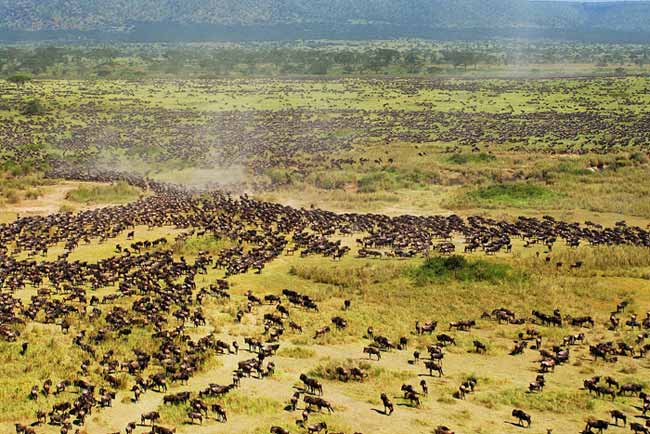Humanity's Grassroots: How Grazing Animals Shaped Evolution

Secrets regarding the spread of the world's grasslands — which proved vital to countless species of grazing animals and may have influenced humanity's evolution — have now been uncovered in fossil teeth, scientists reveal.
These new findings show when the ancestors of elephants, rhinos, hippos, cattle, pigs and other lineages of herbivores began grazing on grasses, helping create the landscape wherein our own species developed.
Since such grasses thrive in warmer climates, the researchers say the findings could be a peek at what's to come in a warming world.
Grasslands now cover more than 20 percent of the planet's lands, but the savannahs of Africa only emerged shortly before the hominids that gave rise to humanity evolved. Although the cool-season, or so-called C3, grasses developed more than 65 million years ago, soon before the end of the age of dinosaurs, the warm-season, or C4, grasses found in savannahs evolved 25 million to 35 million years ago and emerged in Africa just 10 million years or so ago.
"Corn is C4, sugarcane is C4," researcher Kevin Uno, a geologist at the University of Utah, told LiveScience. "Although C4 grasses make up less than 1 percent of all plant species in the world, they are responsible for 30 percent of all biomass on Earth. Humans evolved in a world where C4 grasses were available. These are the plants we rely on for food. They made a big impact."
To understand how animals in Africa adapted to these new grasses, switching over from a diet of leaves from C3 trees and shrubs to C4 grasses, Uno and his colleagues investigated 452 fossil teeth of herbivores from three sites in Kenya also occupied by ape-like human ancestors.
"The opening of the landscape, which we can see in the increasing abundance of grazing mammals, led eventually to the conditions where the lineage of primates, leading to us, were able to evolve," researcher Thure Cerling, a geologist at the University of Utah, told LiveScience. "Without the opening of the landscape and development of savannas, we would not have evolved."
Get the world’s most fascinating discoveries delivered straight to your inbox.
In the kind of photosynthesis that C3 plants rely on, the carbon-12 isotope, which has the lightest molecular weight of stable carbon isotopes, is preferred. In C4 photosynthesis, both carbon-12 and the heavier carbon-13 isotope are used. Depending on the food eaten, an animal would integrate certain ratios of carbon isotopes into its body tissues. By measuring ratios of these isotopes in the enamel of fossil teeth and determining the ages of the sediments they were found in, the scientists could figure out if herbivores ate C3 plants, C4 plants or a mix, and when they "hit the hay," so to speak, constructing a 7-million-year record of dietary change from 10 million to 3 million years ago.
"Grass is now the main food for many herbivores in East Africa," Uno said.
The first animals to switch to warm-season grasses were zebras' ancestors, starting 9.9 million years ago. "Horses were ready for the 'new restaurant' and went exclusively to this new food resource," Cerling said.
Next, some but not all rhinos made the switch beginning 9.6 million years ago. This was also true of the bovids, which today include gazelles, wildebeest and Cape buffalo. Grass-grazing spread 7.4 million years ago to the ancestors of elephants, and once it did, they remained grazers until very recently, probably in the last million years or so. Today, African and Asian elephants eat mostly C3 trees and shrubs.
Hippos began grazing on grass more slowly, as did suids, the ancestors of bush pigs and warthogs. And giraffes never left the salad bar of trees and shrubs, in part because their long necks are designed to get to leaves up high, not grass down low.
The first herbivores to eat these C4 plants had longer teeth — meant for tearing through leaves — that took more time for the abrasive grasses to wear down. The increased availability of these grasses meant there was a new food source available for any herbivore to try if they could digest them, as they have more cellulose and lower nutritional quality than most C3 plants.
"If you lived in a town that only ate beef for dinner and the frozen fish stick guy came through selling TV dinners at half price because everyone ate beef, wouldn't you at least try fish for dinner?" Uno asks. "That example is a bit anthropomorphized, but I see C4 grasses as new resources that may not have been as much in demand as C3 cool-season grasses, trees and shrubs. This could be because some animals had a hard time digesting C4 grasses."
It remains a mystery as to why the C4 plants became as important in global ecosystems as they did, Cerling said. No evidence of widespread grasslands has been found earlier than 4.2 million years ago in East Africa.
"Only during the past 1 million years did grasslands become as dominant as they are today in East Africa," Uno said. Still, even before 4.2 million years ago, "there was enough C4 grass around for a whole bunch of animals to make a living off of it," he added.
Global or regional changes in climate have the potential to change a forest into grassland or vice versa. When this happens over large areas, animals must alter their diets or deal with the consequences, which in extreme cases could mean moving to a new habitat or eventually going extinct.
"As we continue to add to atmospheric carbon dioxide through the burning of fossil fuels, we'll give C3 plants a competitive advantage," Uno said. "We don't know the full series of potential outcomes of that, but it's certainly an issue that plant ecologists are well-attuned to."
The scientists detailed their findings online today (April 4) in the journal Proceedings of the National Academy of Sciences.
You can follow LiveScience on Twitter @livescience.



